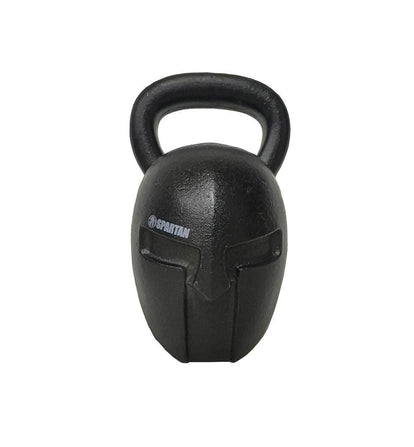The 5 Spartan Rules to Master Your Kettlebell Workouts

If you’ve tried any of our Spartan Fit workouts, you’ve probably picked up on one tool that we give a lot of attention to: the kettlebell. “The reason I like a kettlebell opposed to a dumbbell — even though I like them both a lot — is the kettlebell helps put your body in a good position when lifting,” says Spartan Director of Training Sam Stauffer.
“Just grabbing the kettlebell and trying to break the bar in half is automatically going to pack your shoulders, put your chest up, engage your core, and put your back into a good position for moves like the deadlift and goblet squat, among many others,” says Stauffer. “Basically, this simple cue helps prepare your body for any movement to come.”
Related: Trevor Franklin's 3 Days of Bells program on the Spartan FIT app
But don’t take this as your cue to start throwing around kettlebells with wild abandon. You need to know the basics before you can get fancy. “The kettlebell swing is where I see a lot of injuries come into play,” says Stauffer. “It requires motor repatterning, so your brain actually has to take on a huge task to learn what it should and shouldn't feel like.”
Kettlebell Training: Tips for Serious Spartans
So before you start swinging, commit these rules to memory:
Rule #1: Always Deadlift the Kettlebell
“If you can't deadlift properly, get the swing out of your arsenal because the swing is a ballistic deadlift,” says Stauffer. “The kettlebell deadlift in general is a great teaching exercise that will come into play for many kettlebell moves."
One of the most common mistakes Stauffer sees is that athletes don’t pick up the bell correctly, and that can really throw a tweak in your back and put you on the couch for a few weeks, he warns. So whether you're doing a goblet squat or racking the weights to your shoulders in preparation for a press, make sure that you're deadlifting it up into that position. That way, you're not rounding at the back or letting your shoulders loose. Once you get more advanced and master the mechanics, you can start to clean it into position.
Try doing 5 sets and 5 reps of kettlebell deadlifts 2 to 3 times a week to start.
Rule #2: Rack the Bell to Protect your Wrists
Whether you’re doing a single- or double-racked position, gripping the kettlebell with a firm grip is key, says Stauffer. The second key is knowing how to rest the bell on your wrists. That really comes down to elbow position — they should be flared out from your body by about 45 degrees, with your thumbs tight against your chest. “If your elbows were pointing directly down towards the ground, that’s going to put a lot of unnecessary weight on your wrists,” Stauffer says.
Related: Can You Become Super Fit With Just a Full-Body Kettlebell Workout?
Rule #3: Go Heavier Than You Think
“If you have too light of a weight, like if you've ever tried an Olympic lift with just a barbell, it's very challenging,” Stauffer says. “If you throw two 25s on the side, all of a sudden, you go, ‘Okay, I can do this.’” It's the same thing with a kettlebell, and the swing in particular. “Because it's a ballistic movement, if you're putting all your force into a 10-pound kettlebell, that thing is going to shoot up to the sky.”
So, once you learn the movement and you have an understanding of it, choosing a weight that's appropriate for you is huge. Stauffer recommends going off of your kettlebell deadlift or squat weight. “If you can kettlebell deadlift a certain weight, you're going to be able to swing something close to that,” Stauffer says. “Or if you can goblet squat 50 pounds, you might want to scale down just a bit from that, but you're probably going to be able to swing that as well.”
Rule #4: But Make Sure Your Form Is on Point
“It all comes down to being super aware of every move that you're doing,” Stauffer says. In particular, with any kettlebell movement, you have to be conscious of what your back is doing. “Most people are going to break down and start hunching at the shoulders, which is going to translate right down to the lumbar spine, especially when they're swinging, cleaning, or picking the kettlebell off the ground,” Stauffer says.
In addition to watching out for that shoulder hunch, take note of your rib cage and whether it flares out as you lift. That’s a sign that the lumbar spine is going into hyperextension in order to get the weight up — and it’s a sign that you should drop the weight or go back to the basics.
Watch how to execute the perfect kettlebell swing here.
Rule #5: Watch Your Own Tape
The next best thing to having a coach is being your own coach. Get a friend to video you doing your kettlebell moves so you can get external feedback by watching the tapes. “You just don’t know what you look like, even myself, and I’ve been doing these movements for a long time,” Stauffer says. “In your mind, you make up this picture of, ‘Oh yeah, I'm squatting so well right now,’ and every once in a while, you'll catch a glimpse of a video and you're like, ‘My hips are too low,' or, 'I'm really sinking too far.’ So videoing is definitely a very powerful tool.”










